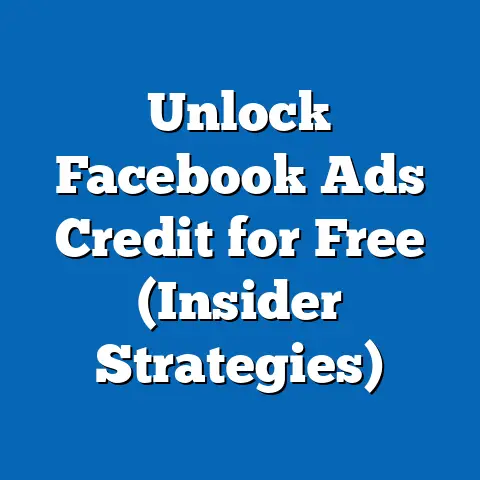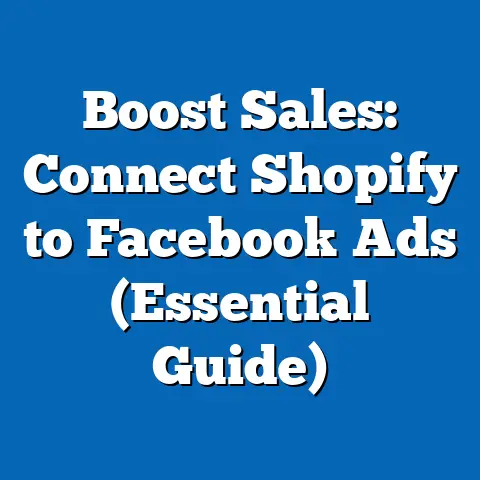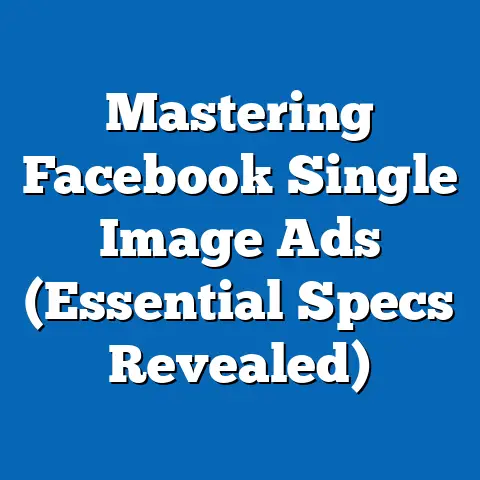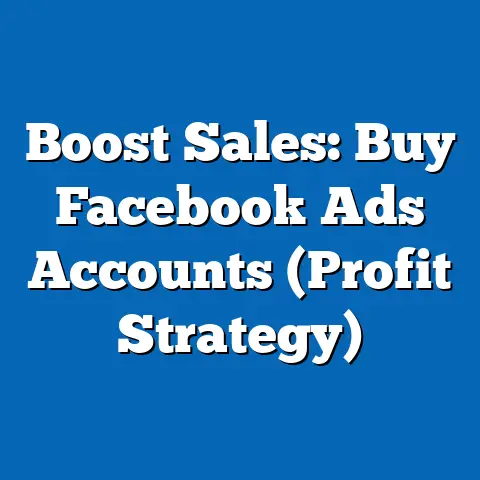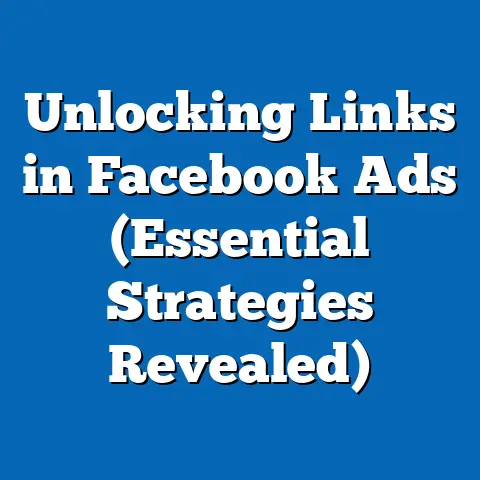Turn Facebook Ads into Authentic Connections (Savvy Strategies)
In today’s digital world, where consumers are bombarded with advertisements at every turn, standing out from the crowd requires more than just clever taglines and eye-catching visuals. I’ve seen firsthand how the most successful Facebook ad campaigns aren’t the ones that shout the loudest, but the ones that whisper a story, share a value, and build a genuine connection with their audience. Think of it like this: are you more likely to remember the pushy salesperson or the friendly face that took the time to understand your needs?
The truth is, consumer expectations have evolved. People are no longer passive recipients of marketing messages; they’re active participants seeking brands that align with their values and understand their needs. They crave authenticity, transparency, and a sense of community. So, how can you transform your Facebook ads from mere product placements into tools for meaningful engagement? That’s what I’m going to unpack for you in this guide. We’ll dive deep into savvy strategies that will help you understand your audience, craft authentic messages, leverage user-generated content, engage through interactive content, and ultimately, build a thriving community around your brand.
According to a recent study by Stackla, 86% of consumers say authenticity is a key factor when deciding what brands they like and support. This statistic alone underscores the importance of shifting your focus from simply pushing products to building genuine relationships. Let’s get started on that journey, shall we?
Understanding Your Audience
Creating authentic connections starts with understanding who you’re trying to connect with. It’s not enough to know basic demographics like age and location; you need to dig deeper and uncover their motivations, aspirations, and pain points. I’ve often found that the more I understand my audience, the more effectively I can tailor my messaging to resonate with them on a personal level.
Gathering Audience Insights
Facebook offers a wealth of tools to help you gather these insights. One of the most powerful is Facebook Audience Insights. This tool allows you to explore the interests, behaviors, demographics, and lifestyles of people on Facebook, both those connected to your page and those who aren’t.
Here’s how I typically use it:
- Start with a broad audience: Begin by selecting a general demographic (e.g., women aged 25-45 in the United States).
- Explore interests: Look at the “Page Likes” section to see what pages this audience is interested in. This can give you clues about their hobbies, passions, and values.
- Analyze demographics: Examine the “Demographics” section to understand their education level, relationship status, and job titles.
- Consider behaviors: Check the “Behaviors” section to see what activities they engage in on Facebook, such as purchasing behavior or device usage.
Another valuable tool is creating customer personas. These are fictional representations of your ideal customers, based on research and data about your existing audience.
To create a customer persona, consider the following:
- Demographics: Age, gender, location, income, education, job title.
- Psychographics: Interests, values, lifestyle, personality.
- Goals and aspirations: What are they trying to achieve?
- Pain points and challenges: What are their biggest frustrations?
- Motivations: What drives their purchasing decisions?
I remember working with a local bakery that wanted to increase its Facebook ad engagement. Initially, they were targeting everyone in a 10-mile radius. After conducting audience research, we discovered that their ideal customer was a young professional, interested in healthy eating and supporting local businesses. We then crafted ads featuring organic ingredients and highlighting the bakery’s commitment to sustainability. The result? A significant increase in engagement and a boost in sales.
Tailoring Messaging for Resonance
Once you have a solid understanding of your audience, you can start tailoring your messaging to resonate with them on a personal level. This means speaking their language, addressing their pain points, and appealing to their values.
Here are a few tips:
- Use “you” language: Focus on the benefits your product or service offers to the customer, rather than just listing features.
- Address their pain points: Show that you understand their challenges and offer solutions.
- Appeal to their values: Highlight how your brand aligns with their beliefs and principles.
- Use visuals that resonate: Choose images and videos that are relevant to their interests and lifestyle.
Take, for example, Patagonia. They consistently tailor their messaging to resonate with their audience’s passion for environmental conservation. Their ads often feature stunning visuals of nature and highlight their commitment to sustainable practices. This approach has helped them build a loyal following of customers who share their values.
Key Takeaway: Understanding your audience is the foundation for creating authentic connections. Use Facebook Audience Insights and customer personas to gather deep insights and tailor your messaging accordingly.
Crafting Authentic Messaging
Now that you understand who you’re talking to, let’s focus on what you’re saying. Crafting authentic messaging is about more than just writing compelling copy; it’s about telling a story, sharing your values, and being transparent with your audience. I’ve found that the most effective Facebook ads are the ones that feel less like advertisements and more like genuine conversations.
The Power of Storytelling
Storytelling is a powerful tool for creating emotional connections with your audience. Stories have the ability to capture attention, evoke empathy, and make your brand more relatable.
When crafting a story for your Facebook ad, consider the following:
- Identify your core message: What do you want your audience to take away from the story?
- Create a compelling narrative: Use characters, plot, and conflict to engage your audience.
- Make it relatable: Connect the story to your audience’s experiences and emotions.
- Show, don’t tell: Use vivid language and imagery to bring the story to life.
I worked with a small non-profit organization that provided support to families affected by childhood cancer. Initially, their Facebook ads focused on statistics and donation appeals. While these ads were informative, they didn’t evoke a strong emotional response. We decided to create a series of video ads featuring the stories of families who had benefited from their services. These stories were raw, honest, and deeply moving. As a result, donations skyrocketed, and the organization was able to reach more families in need.
Transparency and Honesty
In today’s world, consumers are more skeptical than ever. They want to know who they’re doing business with and what they stand for. That’s why transparency and honesty are crucial for building trust with your audience.
Here are a few ways to be transparent in your Facebook ads:
- Share your company’s values and mission: Let your audience know what you believe in and what you’re working towards.
- Be upfront about your pricing and policies: Avoid hidden fees or misleading claims.
- Acknowledge your mistakes: If you make a mistake, own up to it and apologize.
- Respond to customer feedback: Show that you’re listening to your audience and addressing their concerns.
Buffer, a social media management platform, is a great example of a brand that prioritizes transparency. They openly share their revenue, expenses, and even their salaries. This level of transparency has helped them build a strong community of loyal customers who trust their brand.
Key Takeaway: Crafting authentic messaging is about telling stories, sharing your values, and being transparent with your audience. This will help you build trust and create emotional connections that resonate with your target audience.
Leveraging User-Generated Content
User-generated content (UGC) is any form of content, such as images, videos, reviews, or testimonials, that has been created by your customers or fans. It’s one of the most powerful tools for building authentic connections because it provides social proof and shows that real people are using and loving your products or services. In my experience, UGC can significantly boost engagement and credibility.
Encouraging and Utilizing UGC
There are several ways to encourage and utilize UGC in your Facebook ads:
- Run a contest or giveaway: Ask your customers to submit photos or videos of themselves using your product for a chance to win a prize.
- Create a branded hashtag: Encourage customers to share their experiences using a specific hashtag.
- Ask for reviews and testimonials: Request feedback from satisfied customers and feature their quotes in your ads.
- Partner with influencers: Collaborate with influencers who align with your brand and have a strong following among your target audience.
GoPro is a master of UGC. They regularly feature videos and photos submitted by their customers, showcasing the amazing adventures people are having with their products. This not only provides social proof but also inspires others to get out and create their own content.
Benefits of UGC
The benefits of using UGC in your Facebook ads are numerous:
- Builds community: UGC creates a sense of belonging and encourages customers to connect with each other.
- Enhances credibility: UGC is seen as more trustworthy than traditional advertising because it comes from real people.
- Increases engagement: UGC is more likely to capture attention and generate engagement than branded content.
- Reduces advertising costs: UGC can be a cost-effective way to create high-quality content.
I worked with a local clothing boutique that was struggling to gain traction on Facebook. We decided to run a contest asking customers to submit photos of themselves wearing the boutique’s clothing. The response was overwhelming. Customers loved showing off their style, and the boutique was able to create a library of high-quality UGC that they could use in their ads. As a result, their engagement skyrocketed, and their sales increased significantly.
Key Takeaway: User-generated content is a powerful tool for building authentic connections. Encourage your customers to share their experiences and feature their content in your Facebook ads to build community, enhance credibility, and increase engagement.
Engaging Through Interactive Content
In today’s fast-paced digital world, capturing and maintaining attention is a constant challenge. That’s where interactive content comes in. Interactive content, such as polls, quizzes, and live videos, can create two-way interactions between brands and consumers, fostering deeper connections and increased brand loyalty. I’ve seen firsthand how these formats can transform passive viewers into active participants.
Interactive Content Formats
Here are a few interactive content formats you can use in your Facebook ads:
- Polls: Ask your audience a question and let them vote on the answer. This is a great way to gather feedback and spark conversation.
- Quizzes: Create a fun and engaging quiz that tests your audience’s knowledge or helps them discover something about themselves.
- Live videos: Host a live Q&A session, demonstration, or behind-the-scenes tour. This allows you to connect with your audience in real-time and answer their questions.
- Interactive stories: Use Facebook Stories to create interactive experiences, such as polls, quizzes, and question stickers.
I worked with a fitness studio that wanted to increase its Facebook ad engagement. We decided to run a series of live video workouts. These workouts were free and accessible to anyone on Facebook. The studio’s instructors led the workouts, answered questions, and provided encouragement. The response was incredible. People loved being able to workout from home, and the studio was able to build a strong community of loyal followers.
Fostering Community and Dialogue
Interactive content is not just about promoting your products or services; it’s also about fostering community and dialogue. When you create opportunities for your audience to interact with your brand and with each other, you’re building deeper connections and increasing brand loyalty.
Here are a few tips for using interactive content to foster community and dialogue:
- Ask open-ended questions: Encourage your audience to share their thoughts and opinions.
- Respond to comments and questions: Show that you’re listening to your audience and engaging with them.
- Create a sense of exclusivity: Offer special deals or content to those who participate in your interactive content.
- Encourage user-generated content: Ask your audience to share their own photos, videos, or stories related to your brand.
Domino’s Pizza is a great example of a brand that uses interactive content to foster community and dialogue. They regularly run polls and quizzes asking their audience about their favorite toppings, pizza combinations, and delivery experiences. They also respond to comments and questions, creating a sense of engagement and connection.
Key Takeaway: Engaging through interactive content is about creating two-way interactions between brands and consumers. Use polls, quizzes, live videos, and interactive stories to foster community, spark dialogue, and increase brand loyalty.
Building Community Around Your Brand
Finally, let’s talk about the big picture: building a community around your brand. This is the ultimate strategy for creating authentic connections because it transforms transactional relationships into long-term brand loyalty. I’ve consistently seen that brands with strong communities are the ones that thrive, even in the face of competition.
Facebook Groups and Community Engagement
One of the best ways to build a community on Facebook is to create a Facebook Group. This allows you to bring together your customers and fans in a dedicated space where they can connect with each other, share their experiences, and engage with your brand.
Here are a few tips for building a thriving Facebook Group:
- Choose a specific topic: Focus on a topic that is relevant to your brand and interests your target audience.
- Create a welcoming environment: Set clear guidelines for behavior and moderate the group to ensure a positive and respectful atmosphere.
- Provide valuable content: Share helpful information, tips, and resources that your members will appreciate.
- Encourage engagement: Ask questions, run polls, and host live events to keep your members engaged.
- Recognize and reward your most active members: Show your appreciation for those who contribute to the community.
Lululemon has built a thriving Facebook Group called “lululemon Studio Community,” where members can connect with each other, share their fitness goals, and get support and encouragement. The group is moderated by Lululemon employees who provide valuable content and answer questions.
Transforming Transactional Relationships
Building a community is about more than just creating a space for people to connect; it’s about transforming transactional relationships into long-term brand loyalty. When you foster a sense of belonging and connection, you’re creating a powerful emotional bond that keeps customers coming back.
Here are a few ways to transform transactional relationships into long-term brand loyalty:
- Provide exceptional customer service: Go above and beyond to meet your customers’ needs and exceed their expectations.
- Personalize the customer experience: Use data and insights to tailor your interactions to each customer’s individual preferences.
- Show your appreciation: Thank your customers for their business and recognize their loyalty.
- Give back to the community: Support causes that are important to your customers and demonstrate your commitment to social responsibility.
Starbucks is a great example of a brand that has successfully built a community around its brand. They provide a welcoming atmosphere in their stores, offer personalized service, and give back to the community through various initiatives. As a result, they have a loyal following of customers who feel a strong connection to their brand.
Key Takeaway: Building a community around your brand is the ultimate strategy for creating authentic connections. Use Facebook Groups and community engagement initiatives to foster a sense of belonging and connection, transforming transactional relationships into long-term brand loyalty.
Conclusion
In conclusion, the key to turning Facebook ads into authentic connections lies in prioritizing relationships over mere transactions. By understanding your audience, crafting authentic messages, leveraging user-generated content, engaging through interactive content, and building a community around your brand, you can transform your Facebook ads from product placements into powerful tools for meaningful engagement.
Remember, authenticity is not just a buzzword; it’s a fundamental principle that drives consumer behavior. As the digital landscape continues to evolve, the brands that prioritize genuine connections will be the ones that thrive. So, take these savvy strategies, implement them in your campaigns, and watch as your Facebook ads transform into bridges that connect you with your audience on a deeper, more meaningful level. The future of advertising is not about shouting the loudest; it’s about whispering the right message to the right people and building relationships that last.

